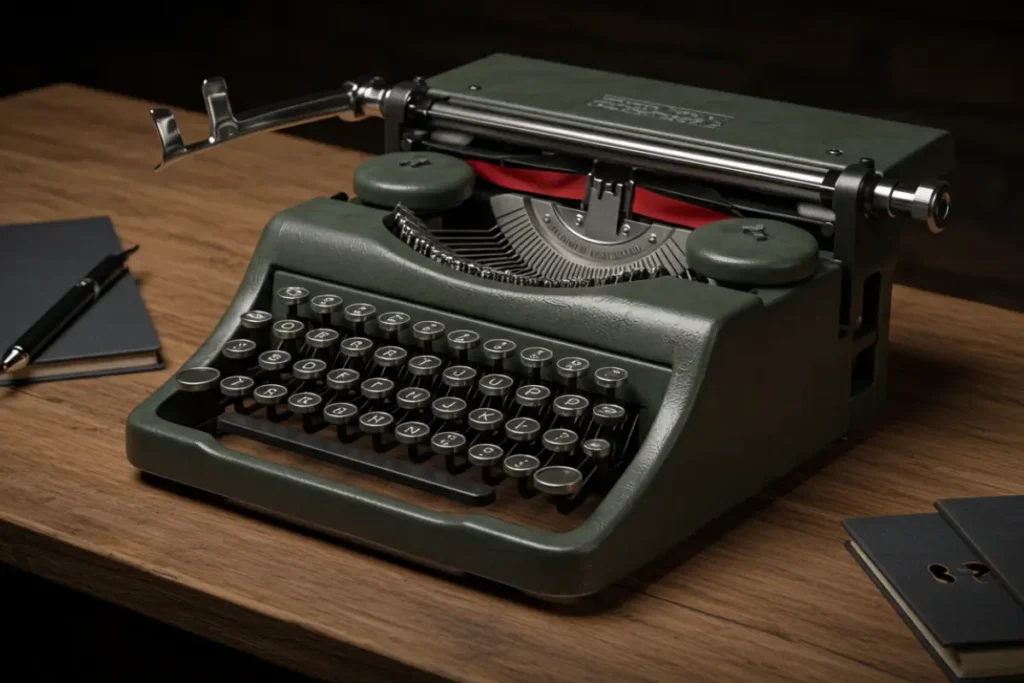Hey there, fellow keyboard enthusiasts! I’m Erick, and as someone who has a deep passion for the world of keyboards, I’ve seen how much technology has evolved over the years.
One of the most interesting evolutions in the world of typing devices has been the clicky switches—those loud, satisfying keypresses that so many of us either love or hate.
I really like topics like this about the evolution of something, and today we are talking about clicky keyboards, we also have a topic about keyboards in general that I think you might find interesting to check out.
They’ve come a long way from the mechanical wonders used in the typewriters of the early 20th century to today’s gaming and mechanical keyboards that offer a unique typing experience.
Whether you’re a typist, gamer, or just a tech enthusiast, the clicky switch has a special place in the history of keyboards.
In this article, I’m going to take you on a journey through the fascinating history of clicky switches, showing you how they evolved from typewriters all the way to their current use in modern gaming and office keyboards.
I’ll share some cool facts, the evolution of these switches, and why they remain so beloved by many. Plus, I’ll include some tips, fun facts, and even some recommendations on where you can explore these switches in today’s market. If you love the sound of a keypress, stick around, this one’s for you!

A Brief History of Clicky Switches: From Typewriters to Early Keyboards
Let’s go back in time for a moment, all the way to the late 1800s. Believe it or not, the very first “clicky” switches were used in typewriters!
These machines were a staple in offices and homes alike, and their mechanical keys provided that satisfying tactile feedback that people still love today.
The distinctive “click” you hear when you press a key on a typewriter is the earliest form of what would eventually evolve into the mechanical switches we use in modern keyboards.
In the early 20th century, the typewriter was the king of typing devices. People relied on the mechanical keys to write everything, from letters to novels.
The clicking sound that the typewriter produced wasn’t just a sound; it was a part of the mechanical process that gave typists feedback about their actions. The click signaled that the key had been pressed fully, helping writers maintain rhythm and accuracy.
Fast forward to the 1970s, when computers started replacing typewriters. The very first computer keyboards were designed to mimic the mechanical feel and sound of typewriters.
Fun Fact: The first computer keyboards, just like typewriters, had mechanical switches—but these were still a far cry from the advanced switches we use today. They were often much bulkier and less refined, yet still managed to offer that signature clickiness that we all crave.
Mechanical Keyboards and the Rise of Clicky Switches in the 1980s and 1990s
By the 1980s, mechanical keyboards were starting to take over the world of computers, and companies like IBM were at the forefront of this revolution. They introduced the Model M keyboard, which is still considered one of the most iconic mechanical keyboards ever created.
The Model M used buckling spring switches, which produced a loud, satisfying click every time you pressed a key. This “clicky” sound was a defining feature of mechanical keyboards at the time and remains beloved to this day.
Clicky switches quickly gained popularity because of their tactile feedback and distinct auditory sound. In the early 1990s, however, a shift began. Many people wanted quieter, softer keyboards for office use, so membrane keyboards started to take over.
These are the types of keyboards that use rubber domes beneath the keys to produce a much quieter sound. But for those of us who love the clicky feedback, mechanical keyboards never really went away.
They continued to be the choice of gamers and typists who preferred the tactile feel and the audible confirmation of each keypress.
Fun Fact: The clicky sound is actually a design feature. It’s meant to act as a form of feedback to let you know that your keypress was successful. For many, it’s an essential part of the typing experience!

The Resurgence of Clicky Switches: Gaming and the Modern Era
Fast forward to the 2000s and beyond, and the clicky switch saw a major resurgence in the gaming and tech community. The rise of gaming keyboards led to a newfound love for mechanical switches, with companies like Corsair, Razer, and Logitech leading the charge.
These companies designed switches that were not only clicky but also incredibly durable and responsive, making them perfect for fast-paced gaming.
Clicky switches became a hit in the gaming world because of the responsiveness they provided. For gamers, every keypress needs to be as fast and accurate as possible. The audible “click” and tactile feedback of the switches allow them to feel their inputs, making them better equipped for those intense gaming sessions.
Gamers love knowing they’ve hit the right key at the right time, and that’s why clicky switches are often the preferred choice for those in competitive gaming.
Pro Tip: If you’re a gamer, clicky switches, like the Cherry MX Blue or Razer Green, are fantastic for gaming because they offer tactile feedback and a loud sound that tells you your keypress was registered.
Why Do People Love Clicky Switches?
Now that we’ve seen the evolution of clicky switches, let’s talk about why so many people love them. For some, it’s the satisfaction of hearing that loud click with every keypress. The feedback they get from the sound and feel makes them feel more connected to their work, whether it’s typing a long document or gaming.
- Tactile Feedback: Clicky switches give a solid tactile response with every keypress. You can actually feel when the key has been activated, making typing much more comfortable and efficient.
- Auditory Feedback: For many people, the sound of the click is not just noise; it’s a form of reassurance. It lets you know that your input has been accepted, which can boost productivity.
- Nostalgia: For some, the sound and feel of clicky switches bring them back to the days of typewriters, where typing was an art form. It’s a satisfying experience for those who long for the past.

Common Types of Clicky Switches You Should Know About
If you’re considering making the switch to a mechanical keyboard with clicky switches, you’ll need to know a few options. Here are the most common clicky switches available today:
- Cherry MX Blue: One of the most popular clicky switches, known for its satisfying click and tactile bump.
- Razer Green: Found in many of Razer’s keyboards, these switches are very similar to Cherry MX Blues but are a bit louder.
- Cherry MX Green: A stiffer variant of the Cherry MX Blue, requiring more force to press the key.
- Logitech Romer-G: A quieter alternative to the traditional clicky switches but still offers tactile feedback.
Conclusion
The evolution of clicky switches from their humble origins in typewriters to their resurgence in modern-day gaming keyboards shows just how much the world of typing technology has evolved.
I don’t think clicky switches will ever be built into keyboards as standard, but that’s just my guess.
If you liked this article, don’t forget to comment below and share your thoughts on your favorite clicky switches! 😊 Also, be sure to check out my other articles at Keyboards Technology.
You’ll find tons of helpful information for keyboard enthusiasts just like you!
See More
- The Best and Worst Mechanical Switches: A Tier List
- Mechanical Keyboard Brands Ranked from S-Tier to D-Tier
- How to Make Your Keyboard Quieter Without Replacing It
FAQs
What are clicky switches used for?
Clicky switches are mainly used for typing and gaming. They provide tactile and auditory feedback, which makes them ideal for gamers who need precision and typists who enjoy the feedback.
Are clicky switches good for gaming?
Yes! Many gamers prefer clicky switches because they offer great tactile feedback and audible confirmation, which helps in fast-paced games.
Why are clicky switches loud?
Clicky switches are loud because they are designed to provide feedback through sound. The “click” is a part of the switch’s mechanism that signals the user that the key has been pressed.
If you enjoyed this article, make sure to share it and leave a comment! 😊


